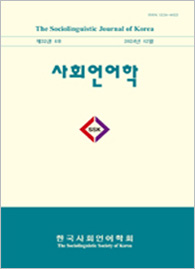![]() Journal Search Engine
Journal Search Engine
ISSN : 1226-4822(Print)
The Sociolinguistic Journal of Korea Vol.32 No.4 pp.123-147
DOI : http://dx.doi.org/10.14353/sjk.2024.32.4.05
DOI : http://dx.doi.org/10.14353/sjk.2024.32.4.05
A study of variation and change in the use of {ne} and {je} in dramas from the 1990s and 2010s
Abstract
This study examined the differences in the use of {ne} and {je} in Korean dramas from the 1990s and 2010s in terms of gender and discourse situations. The research focuses on how male and female characters use {ne} and {je} differently in public and private contexts for each era, and how these patterns have changed over time. The findings are summarized as follows. First, in the 1990s, men primarily used {je} in public settings and alternated between {ne} and {je} in private contexts, indicating a context-dependent usage pattern. Women, on the other hand, mainly used {je} in both public and private situations, but {ye} appeared more frequently in public settings, showing that women also adjusted their usage according to the context. Second, in the 2010s, men used both {ne} and {je} regardless of the discourse context, while women predominantly used {ne} across contexts. Third, compared to the 1990s, the use of {ne} in public situations increased for both men and women in the 2010s, indicating a notable change, while no change was observed in private settings.
초록
Vol. 40 No. 4 (2022.12)

Frequency Published four times annually in March, June, September, and December
Doi Prefix 10.14353/sjk.
Year of Launching 1993
Publisher The Sociolinguistic Society of Korea



Online Submission
socioling.jams.or.kr
The Sociolinguistic
Society of Korea
socioling.com
Editorial Office Contact Information
- Tel: +81-10-3894-3164
- E-mail: schang@hoseo.edu






